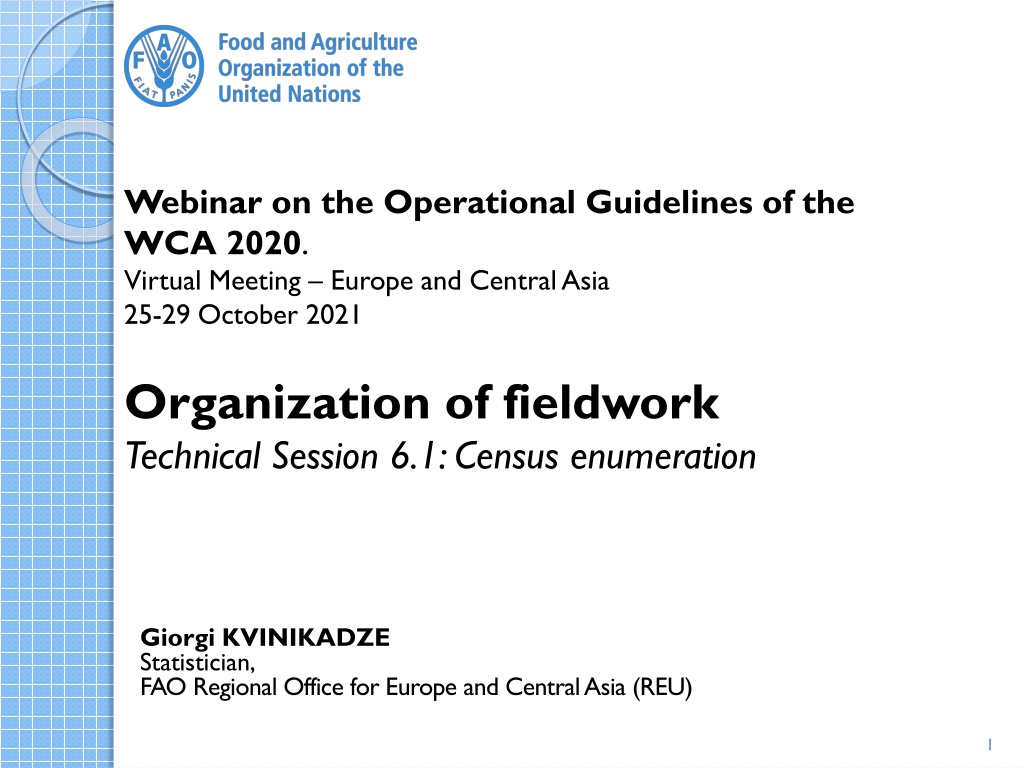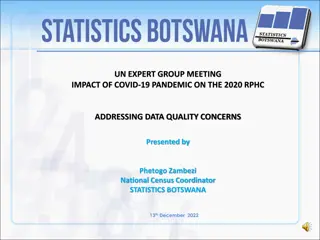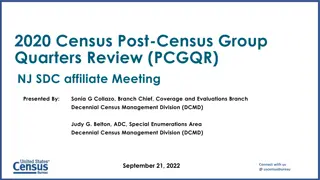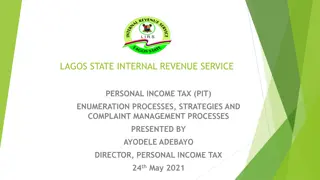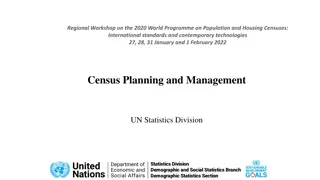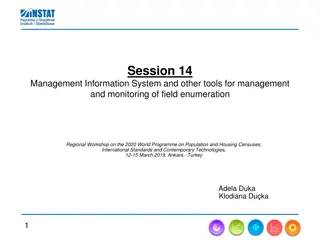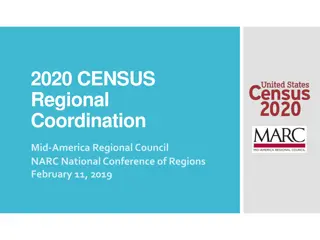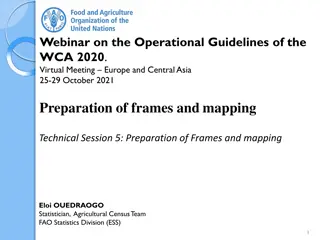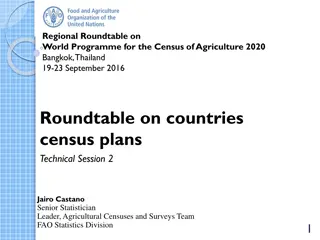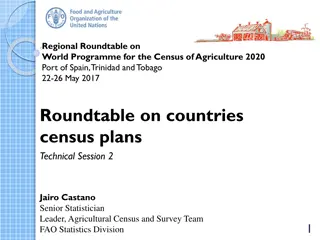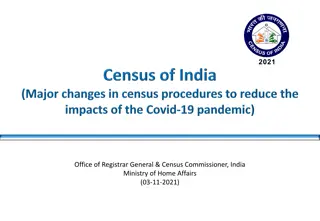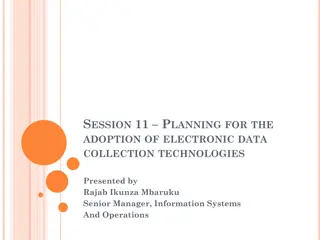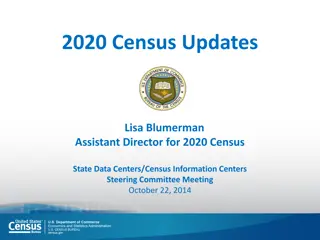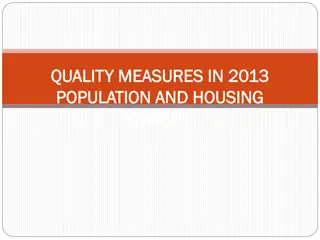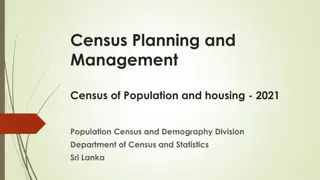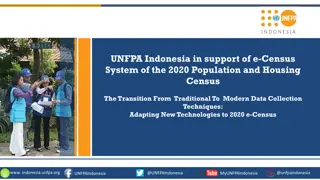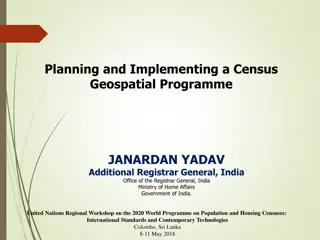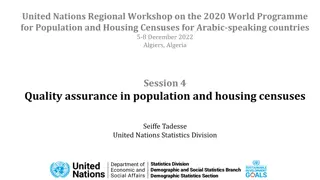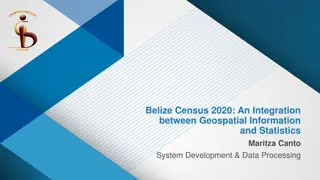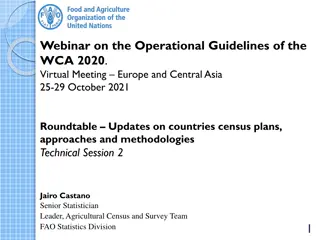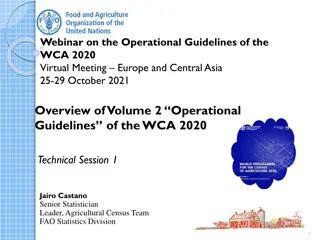Operational Guidelines for WCA 2020 Census Enumeration Webinar
This webinar focuses on the operational guidelines for the WCA 2020 Census Enumeration, covering key steps such as pre-test surveys, pilot census, listing operation, and organization of census enumeration. It emphasizes the importance of careful planning to enhance the effectiveness of the census process through timely problem identification and solution. The content includes details on the objectives and methods of pre-test surveys, pilot census, and various aspects of fieldwork organization.
Download Presentation

Please find below an Image/Link to download the presentation.
The content on the website is provided AS IS for your information and personal use only. It may not be sold, licensed, or shared on other websites without obtaining consent from the author. Download presentation by click this link. If you encounter any issues during the download, it is possible that the publisher has removed the file from their server.
E N D
Presentation Transcript
Webinar on the Operational Guidelines of the WCA 2020. Virtual Meeting Europe and Central Asia 25-29 October 2021 Organization of fieldwork Technical Session 6.1:Census enumeration Giorgi KVINIKADZE Statistician, FAO Regional Office for Europe and Central Asia (REU) 1
CONTENT 1. Introduction 2. Pre-test surveys 3. Pilot census 4. Listing operation 5. Organization of census enumeration 6. Monitoring and control of questionnaires flow 7. Census field staff 8. Preparing the face-to-face interview 9. Field enumeration kit and tools 2
Introduction The AC is a large operation that involves complex logistical steps that need to be planned carefully. The organization of the fieldwork involves steps such as pretest surveys, pilot census, listing operation and the organization of the census enumeration in central and provincial offices. Adequate planning of these steps will allow timely identification and solution of problems, to enhance the effectiveness enumeration. of the census 3
Pre-test surveys Its objective is to test different parts of the census methodology, mainly concepts and definitions, formulation of questions, evaluation of alternative methodologies and data collection methods. They are relatively small-scale exercises, tests part of the census instruments and not the entire organization. Selection of respondents is not on a random basis They can contain objective methods of measurement (to find appropriate measurement techniques). Pre-test surveys are relevant for all modalities of census taking They are recommended before taking a decision on the method of data collection (CAPI, CATI, mail-out/mail-back, drop- off/mail-back (or pick-up) or CASI) They should be organized well in advance. 4
Pre-test surveys (contd) Objectives of the pre-test survey: Main purpose: to make sure that the questionnaire is functional, usable, accurate and practical. In particular, to evaluate: the uniformity of the concepts and definitions used; if respondents understand the questions; if the order of questions is acceptable; the duration of interview. Ways to conduct the pre-test survey: Should be conducted in different agricultural zones of the country; Can be used for testing different alternative questionnaires Usually performed by methodologists / statisticians in charge of questionnaire design. 5
Pilot census Objective: to test the overall organization of the census, a dry run for the main census on a limited scale. Should be organised well in advance (at least 1 year), preferably in the same period as the real census, covering all possible conditions faced in the country. Should be large enough to provide adequate information for determining the resource requirements, data checks and monitoring of the field work, logistics, data transfer, mode of tabulation, timetable, various types of biases and errors, updated planning. Excellent opportunity to provide on-the-job training to all supervisory staff Help in determining whether necessary tabulations can be produced easily and adjust the tabulation plan if needed Test the ICT infrastructure and make recommendations for adjustments IMPORTANT: Report on the pilot census with lessons learnt, must be available well in advance of the start of the main census data collection. The lessons should be taken into account before finalizing the operation of the main census.6
Census testing QuestionnaireTesting (pre-tests) Small scale Test the suitability of: census questions, including their formulation and the instructions provided questionnaire design Test in general public and special population groups Estimate time enumeration Several rounds may be needed Pilot Census Larger scale Test the entire census infrastructure Cover one or administrative divisions Test all stages preparatory, processing and tabulation Best if conditions in the pilot census are close to the conditions present during the actual enumeration Ideally one year before the planned census, if not at least 6 months before Even if a pilot census data do not produce usable substantive data, the analysis of errors from the data helps to identify problems. more sizeable of a census: enumeration, requirements in Source: Adapted from the Handbook on the management of PHC rev 2 (UN) Test the data collection methods (e.g. paper,tablets) 7
Listing operation Objective: to identify the census target population (census frame). There are several methods for the listing operation, depending on the socio-economic peculiarities of the country. Practically, in all cases, a list of the agricultural holdings for each enumeration area will have to be prepared, often using EA maps of the most recent population and housing census. Some examples of listing operations to prepare the list of agricultural holdings in the household sector include: a) listing not based on household visits; b) listing based on household visits. 8
Listing operation (contd) a) Listing not based on household visits Involves examining the lists prepared for each local administrative unit (LAU) on the spot together with local leaders, important agricultural holders, members of the local administration, etc., without visiting every household. After the update on the spot, the lists from each LAU are submitted to the regional offices for checking and validation, and then the listing information for the whole region is submitted to the central census office. This method is usually used in countries with compact agglomerations of houses and agricultural land surrounding the agglomeration, when preliminary lists of holdings are available. The listing is done usually several months before the start of the census data collection. This activity could need significant budget resources that should be planned in advance. 9
Listing operation (contd) b) Listing based on household visits Enumerators visit each household to fill-in a listing questionnaire. Two cases: b1) Listing phase conducted before census data collection, either operation or during the population and housing census; b2) Combination of the listing phase with the agricultural census enumeration. as an ad-hoc 10
Listing operation (contd) b1.1) Conducted before census data collection as an ad-hoc operation. A listing questionnaire with several questions allowing to determine whether the household belongs to the census target population or not is used and dwellings of agricultural holders that fulfil the criteria are identified and marked. Advantages: the listing operation can be finalized relatively quicker; the lists obtained before the enumeration help to better organize the field data collection. Limitation: the quality of the frame depends on the time lag between the listing operation and the actual census data collection. Particularity: In some cases, land parcels are first identified (listing of agricultural parcels with their coordinates and information about the land operator). Afterwards in the census office, the holdings are re-composed. b.1.2) Conducted before census data collection during the pop-census Agricultural screening questions are included in the population census questionnaires. 11
Listing operation (contd) b.2) Combination of the listing phase with the agricultural census enumeration All households in the EAs are asked some screening questions (listing questionnaire), to check whether the household fulfils the criteria in the operational definition for agricultural holding. When identification is positive, the enumerator continues with the main interview in the main census questionnaire. Suitable for countries without a possibility to establish preliminary list of holdings from other sources, poor road infrastructure or big distances between households, or remote areas. Advantage: the frame for the census is completely updated. Limitation: field operation takes more time. 12
Organization of census enumeration This discussion refers to data collection through face-to-face interview: Census office A government department, holding the primary and chief responsibility for implementing the census. Provincial offices Provide immediate supervision in each area, established at various levels, such as at provincial and district levels. Coordinate the activities of the field and supervisory staff in the province or district. Main tasks: Organization of training courses of small groups of enumerators and their supervisors Supervision of field work and prompt resolution of mistakes Ability to resolve problems and to motivate enumerators in problematic situations Collection of completed questionnaires Review of completed questionnaires and evaluation Transfer of enumerators from areas where work has been completed to other areas (if needed). 13
Monitoring and control of questionnaires flow Rigorous procedure for registration of completed questionnaires should be established in provincial and central offices. When PAPI is used, special control measures on questionnaires flows are needed: Completed questionnaires returned by enumerators through supervisors to the designated processing center. Questionnaires to be grouped by geographical/admin areas and properly filed. During the processing phase: questionnaires are removed from storage many times for manual editing, data entry and verification. Very rigid control over the flow of questionnaires is needed; periodic reviews in order to detect misplaced questionnaires are useful. An adequate physical storage space is also required. 14
Census field staff Play a critical role in the conduction of agricultural census and their duties should be strictly defined. It is advisable that the field staff, particularly supervisors and enumerators, live in nearby places as they are familiar with local conditions, communicate easily with holders. Usually, one supervisor effectively enumerators. Different ways of organization of field work: 1. each enumerator gets a number of EAs from the supervisor - more common and practiced in cases when enumerators with local knowledge are recruited, they can work alone in their EAs. 2. a small team of supervisor and enumerators is established - they work together on all EAs assigned to the supervisors; may be desirable in difficult areas with poor transport and communication facilities. supervises 5 to 10 15
Census field staff contd Supervisory work Quality checks according to the quality assurance plan for the census on the work of enumerators, including: Observing interviews during enumeration - during the initial period of an enumerator's work, including identification of EAs. Checking holdings enumerated in each EA (face-to-face or by phone): a random sub-sample of holdings, involving an element of surprise. Checking coverage of the EA: by reconciling the forms in the enumeration record with the maps. When using CAPI, done by the software. Reviewing completed census forms to ensure their completeness, accuracy and consistency. Reviewing monitoring and evaluation data for the area under supervision, monitoring progress of enumeration for the area under their supervision, notably: Number/percentage of agricultural holdings visited in an EA Time taken to complete each question/questionnaire Number of questionnaires completed per day Percentage of holdings not interviewed (refusals, non-visited, etc.). 16
Census field staff contd Supervisory work cont d Reporting abnormalities to the census office or taking predefined actions. Involved in collecting questionnaires from enumerators and forwarding them to HQ. Supervision considerably simplified when CAPI is used. Enumeration work Number of enumerators needed for the census operation depends on: volume of work and the length of the census period, content of the questionnaire intensity of agriculture, the number of crop seasons in the year the terrain to be covered compact or widely spread enumeration area transport and communication arrangements. Experience shows that at total for the census not more than 100 to 200 holdings should be assigned to an enumerator if no objective measurement is done, and only 20 to 50 if objective measurements are to be included. Local enumerators usually known by the people and can get maximum cooperation If they are new to the area, they have to be introduced to village leaders and people. Helpers familiar with the people can guide the enumerators around the EA. 17
General suggestions for preparing the face-to-face interview The enumerators should plan their daily routine for interviewing For new enumerators it is desirable to spell out possible problems and possible solutions It is desirable to have advance information about the area of enumeration and the people to be interviewed If the area involved is of one cultural group, it is often wise to interview the leaders first to enlist their cooperation and to have them recommend and introduce the enumerator to others in the group. The same principle is also applicable to organizations or institutions (e.g. a large cooperative) If possible, appointments should be made in advance. 18
Field enumeration kit and tools for face-to-face data collection The kit and tools needed for field data collection vary depending on the method of data collection, content of the questionnaire, countries conditions. Indicative list is given below. Kit for data collection: For PAPI method: o Paper questionnaires o Instructions manual o Calculator o Pencils o Eraser For CAPI method: o CAPI device (Tablets, PDA, smartphone) o Several paper copies of the questionnaire o Spare battery (could be solar battery) o USB memory stick o Spare SIM card from different provider (optional) In addition, for both methods: o GPS device (if not built-in into the CAPI device) o Waterproof bag o Maps of the area assigned (if not incorporated into the device) o Badge for identification o Clip-pad o Torch o First aid kit o Water kit If physical measurements are to be performed (e.g. for a sample in the modules of the modular approach): Animal counter, Crop-cutting tools, Scale, et. Other equipment: Raincoat, Rubber boots, Mosquito /snake/spider protection kit 19
Country example: 2010 Agricultural census Hungary - fieldwork For elaboration of the list of the census units the basic source was the addresses of the Farm Register (FR). Between the AC 2000 and the AC 2010, the FR of private holdings was updated only partially based on the information of the Census of Vineyards and Fruit Plantations 2001, FSSs (2003, 2005 and 2007) and regular annual sample surveys. In the preparation phase of the AC 2010, the FR was completed with information from administrative data sources A pilot survey was carried out before starting census activities for testing census tools The fieldwork of AC 2010 was conducted between 1 June and 21 June 2010. The AC 2010 fieldwork involved 13 500 enumerators, 2 700 supervisors and 270 area agents of the regional directorates The enumerator/supervisor ratio was 5:1 20
THANK YOU 21
